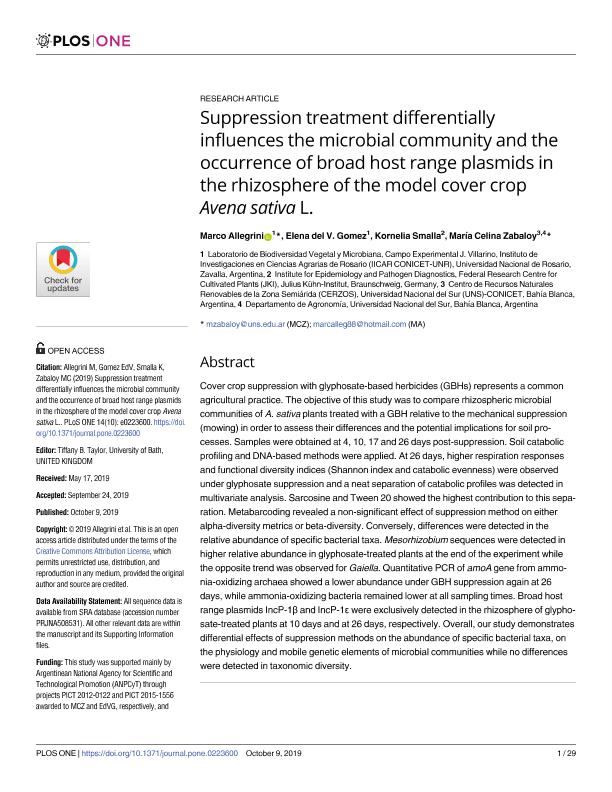Artículo
Suppression treatment differentially influences the microbial community and the occurrence of broad host range plasmids in the rhizosphere of the model cover crop Avena sativa L.
Fecha de publicación:
10/2019
Editorial:
Public Library of Science
Revista:
Plos One
ISSN:
1932-6203
Idioma:
Inglés
Tipo de recurso:
Artículo publicado
Clasificación temática:
Resumen
Cover crop suppression with glyphosate-based herbicides (GBHs) represents a common agricultural practice. The objective of this study was to compare rhizospheric microbial communities of A. sativa plants treated with a GBH relative to the mechanical suppression (mowing) in order to assess their differences and the potential implications for soil processes. Samples were obtained at 4, 10, 17 and 26 days post-suppression. Soil catabolic profiling and DNA-based methods were applied. At 26 days, higher respiration responses and functional diversity indices (Shannon index and catabolic evenness) were observed under glyphosate suppression and a neat separation of catabolic profiles was detected in multivariate analysis. Sarcosine and Tween 20 showed the highest contribution to this separation. Metabarcoding revealed a non-significant effect of suppression method on either alpha-diversity metrics or beta-diversity. Conversely, differences were detected in the relative abundance of specific bacterial taxa. Mesorhizobium sequences were detected in higher relative abundance in glyphosate-treated plants at the end of the experiment while the opposite trend was observed for Gaiella. Quantitative PCR of amoA gene from ammonia-oxidizing archaea showed a lower abundance under GBH suppression again at 26 days, while ammonia-oxidizing bacteria remained lower at all sampling times. Broad host range plasmids IncP-1β and IncP-1ε were exclusively detected in the rhizosphere of glyphosate-treated plants at 10 days and at 26 days, respectively. Overall, our study demonstrates differential effects of suppression methods on the abundance of specific bacterial taxa, on the physiology and mobile genetic elements of microbial communities while no differences were detected in taxonomic diversity.
Palabras clave:
AOB
,
INCP-1
,
GLYPHOSATE
,
METABARCODING
Archivos asociados
Licencia
Identificadores
Colecciones
Articulos(IICAR)
Articulos de INST. DE INVESTIGACIONES EN CIENCIAS AGRARIAS DE ROSARIO
Articulos de INST. DE INVESTIGACIONES EN CIENCIAS AGRARIAS DE ROSARIO
Citación
Allegrini, Marco; Gomez, Elena del Valle; Smalla, Kornelia; Zabaloy, Maria Celina; Suppression treatment differentially influences the microbial community and the occurrence of broad host range plasmids in the rhizosphere of the model cover crop Avena sativa L.; Public Library of Science; Plos One; 14; 10; 10-2019; 1-29
Compartir
Altmétricas




